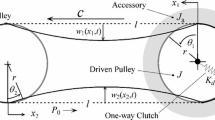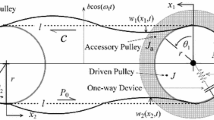Abstract
This is the second paper in the series addressing the constitutive modeling of dynamically loaded elastomeric products such as power transmission belts. During the normal operation of such belts certain segments of the belt structure are loaded via tooth-like cyclical loading. When the time-dependent properties of the elastomeric material “match” the time-scale of the dynamic loading a strain accumulation (incrementation) process occurs. It was shown that the location of a critical rotation speed strongly depends on the distribution (shape) of the retardation spectrum, whereas the magnitude of the accumulated strain is governed by the strength of the corresponding spectrum lines. These interrelations are extremely non-linear. The strain accumulation process is most intensive at the beginning of the drive belt operation, and is less intensive for longer belts. The strain accumulation process is governed by the spectrum lines that are positioned within a certain region, which we call the Strain Accumulation Window (SAW). An SAW is always located to the right of the spectrum line, L i , at log (ω λ i )=0, where ω is the operational angular velocity. The width of the SAW depends on the width of the material spectrum. Based on the following analysis a new designing criterion is proposed for use in engineering applications for selecting a proper material for general drive-belt operations.
Similar content being viewed by others
References
Emri, I., Tschoegl, N.W.: Generating line spectra from experimental responses. Part I: Relaxation modulus and creep compliance. Rheol. Acta 32, 311–321 (1993)
Emri, I., Kramar, J., Hribar, A., Nikonov, A., Florjancic, U.: Time-dependent constitutive modeling of drive belts—I. The effect of geometry and number of loading cycles. Mech. Time-Depend. Mater. 10(3), 245–262 (2006)
Tschoegl, N.W.: The Phenomenological Theory of Linear Viscoelastic Behavior: An Introduction. Springer, Berlin (1989)
Author information
Authors and Affiliations
Corresponding author
Rights and permissions
About this article
Cite this article
Zupančič, B., Emri, I. Time-dependent constitutive modeling of drive belts—II. The effect of the shape of material retardation spectrum on the strain accumulation process. Mech Time-Depend Mater 13, 375–400 (2009). https://doi.org/10.1007/s11043-009-9097-6
Received:
Accepted:
Published:
Issue Date:
DOI: https://doi.org/10.1007/s11043-009-9097-6




